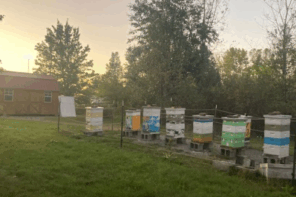By: Lance Hawvermale
This article originally appeared in the Autumn 2020 issue of BEEKeeping Your First Three Years
Mentors are a must for new beekeepers. Hands-on classes help tremendously. Conventional wisdom says to attend a club meeting, make friends with experienced beekeepers, participate in a class, and then have your teacher close by your side as you install that first package or nuc.
But what if you have no access to such assistance? What if, like me, you fell in love with beekeeping from afar but could find no ready instructor or nearby club? You can be a successful solitary beekeeper if you Read, Watch, and Explore.
1. READ
Everybody knows we can learn a lot from books. But what about catalogs? Surprisingly, the aspiring beekeeper can absorb considerable knowledge by browsing any of those voluminous catalogs published by the big beekeeping-supply companies.
“What on earth is a Porter bee escape?” I wondered, seeing several listed for sale. Who was Porter? And why did he want his bees to escape? I used my phone to research these items. A few minutes later I understood the function of this important piece of beekeeping kit. Catalog-browsing inspired me to learn about all sorts of arcane apparatus.
Self-Taught Rule# 1: Request company catalogs and browse every page.
Books, of course, are even better. In these days of ever-changing multimedia, books remain the steadfast champion when it comes to teaching us things we never thought we needed to know. Ever since beekeeping picked up steam in the 1800s, countless books have been published on the subject, examining everything from the construction of top-bar hives to the biology of the bee gut. Whether you’re interested in carpentry, gardening, lip balm, or science, there is a bee book just for you. First, find a sub-topic that interests you, such as first-year beekeeping or queen rearing. Second, hunt down used books that may be out of print; older books may contain fewer fancy pictures, but there’s a lot of mainstay wisdom in those yellowed pages.
When I first felt the distant call to learn about bees, I poked around some dusty shelves and found Practical Beekeeping (Garden Way Publishing, 1977) and studied every black-and-white line drawing. I followed this with The Beekeeper’s Bible (HarperCollins, 2010), with its gorgeous illustrations. These books could not have been more different in regard to their production values, which is why they were so helpful to me; they allowed me to see beekeeping through very different lenses.
Self-Taught Rule #2: Collect and read beekeeping books. www.beeculture.com
A hybrid of book and catalog, honed with the timeliness of a newspaper, the magazine might be the best source of information for the beekeeper who is learning on his or her own. Some periodicals are academic journals that cater to the scientific crowd, while others enjoy a more general purpose audience. Treasures can be found everywhere: in the letters to the editor, in the industry news, and even in the advertisements. The strength of a magazine is that it compiles knowledge from a variety of viewpoints. People in remote villages are keeping bees in hollow logs at the same time that cutting-edge scientists are using nuclear magnetic resonance to authenticate honey. It’s a rich and wonderful world, and the beekeeping magazine brings all of it together, twelve times a year.
Self-Taught Rule #3: Subscribe to at least two beekeeping mags, Bee Culture and BEEKeeping Your First Three Years. (Note: BEEKeeping Your First Three Years ended publication in 2021.)
2. WATCH
In the absence of a mentor by your side, your surrogate instructors are the beekeepers in “how-to” videos. You’ve read about a walk-away split, but how does it actually look? Sifting through the multitude of on line beekeeping videos can be intimidating, especially when each beekeeper has a personal opinion about everything from queen excluders to Varroa control. To narrow the field, check out the list of recommended videos below.
Self-Taught Rule #4: Discover the “vloggers” who have a beekeeping style that appeals to you.
3. EXPLORE
Visit local stores, especially the farmers’ markets and health food vendors. Stand before the honey section and read the labels. Take a jar in your hand. Feel its weight. Make note of its source of origin. Does it claim to be raw, unfiltered, flavored, local, organic? Find out how each of these words applies to honey production. When you harvest your first few jars and pass them around to friends, how will you describe the contents? If you could have any image on your own honey label, what would it be? What plants can you add to your garden for eager pollinators?
Self-Taught Rule #5: Keep your eyes open and think like a beekeeeper, even if you’re not one yet.
Ultimately, you’re on your own. Books, magazines, and videos can improve your beekeeping IQ, but beekeeping wisdom comes only with experience. The solitary beekeeper has two best friends: trial and error.
Recommended Reading:
Mann Lake Beekeeping Supplies Catalog
The Beekeeper’s Problem Solver (ISBN 978-1631590351)
The Backyard Beekeeper (ISBN 9781631593321)
The Hive and the Honey Bee (ISBN 9780915698165)
The New Complete Guide to Beekeeping (ISBN 9780881503159)…and of course Bee Culture Magazine!
Recommended YouTube Channels:
A Canadian Beekeeper’s Blog
Barnyard Bees
U of G Honey Bee Research Centre
Walls Bee Man…and any video featuring Dr. Jamie Ellis









